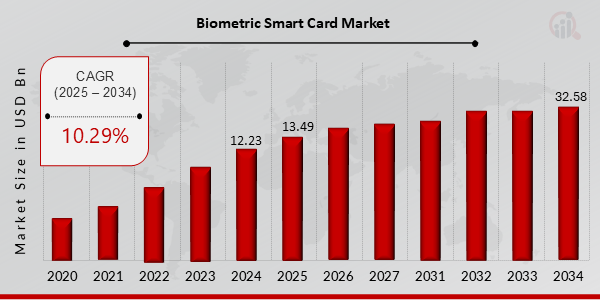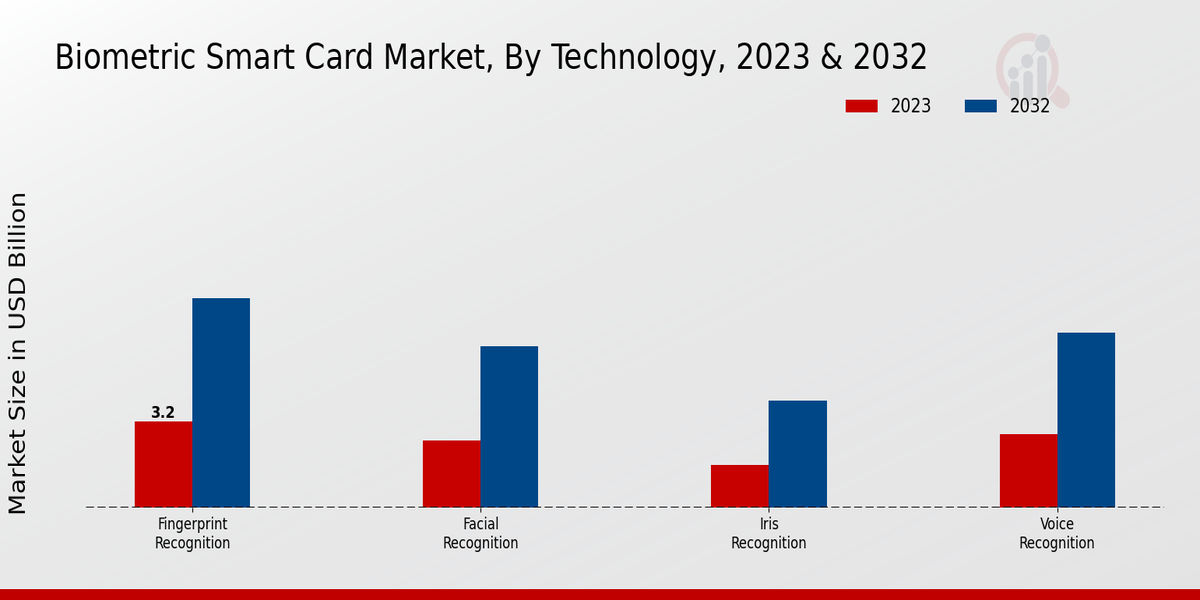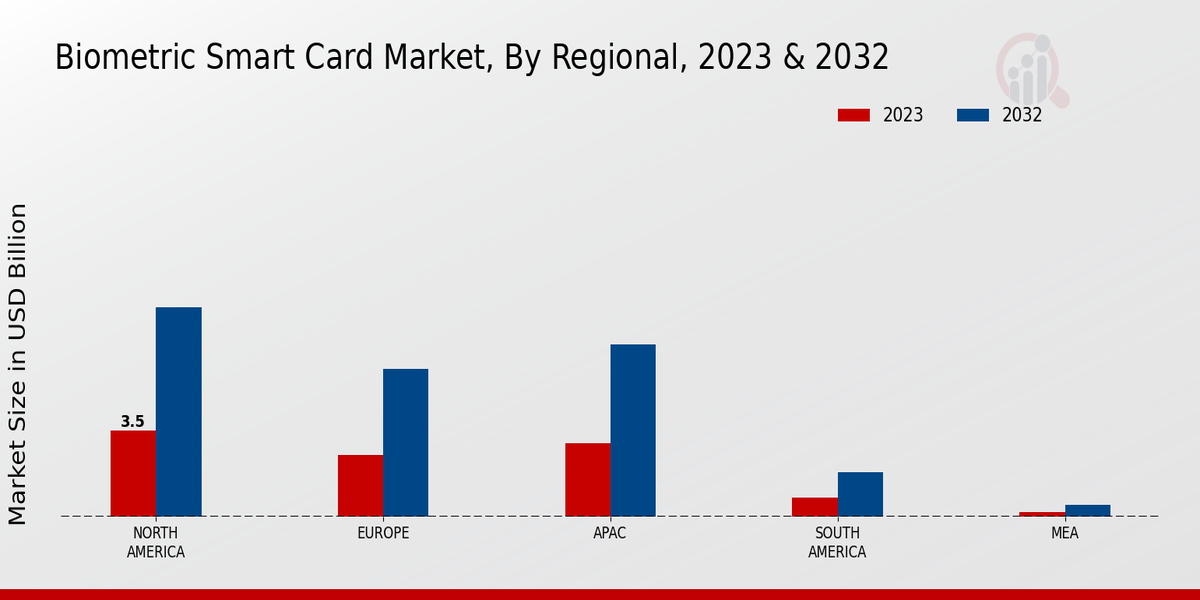Global Biometric Smart Card Market Overview:
Biometric Smart Card Market Size was estimated at 12.23 (USD Billion) in 2024. The Biometric Smart Card Market Industry is expected to grow from 13.49 (USD Billion) in 2025 to 32.58 (USD Billion) till 2034, exhibiting a compound annual growth rate (CAGR) of 10.29% during the forecast period (2025 - 2034)
Key Biometric Smart Card Market Trends Highlighted
The Global Biometric Smart Card Market is experiencing significant growth fueled by various market drivers. Increasing concerns over security and identity theft are pushing organizations and individuals to adopt advanced authentication methods. Biometric smart cards provide a reliable solution that combines authentication and identification capabilities, helping to prevent unauthorized access. Government initiatives aimed at enhancing national security and identity management are also driving the demand for these cards. The growing adoption of digital transactions, coupled with the need for secure payment solutions, further supports this market's expansion.Opportunities in the biometric smart card arena are vast and varied.
Companies can explore advancements in biometric technologies, such as fingerprint, facial recognition, and iris scanning, to enhance card security and user experience. The integration of biometric solutions with mobile technology presents another avenue for growth, enabling the use of smart cards in smartphones and other personal devices. As industries like healthcare, banking, and transportation continue to digitize, the potential for biometric smart cards to streamline operations and improve security remains high.
Recent trends show a distinct shift towards contactless technology within the biometric smart card market.The COVID-19 pandemic accelerated the demand for contactless solutions, encouraging the development of cards that can authenticate users without physical touch. Additionally, there is a growing focus on environmental sustainability leading some manufacturers to explore eco-friendly materials in the production of biometric smart cards. These trends indicate a broader shift towards convenience, security, and sustainability, shaping the future landscape of the biometric smart card industry.
The innovation in card design and implementation methodologies is expected to enhance user experiences, making biometric smart cards a preferred choice in various applications.

Source: Primary Research, Secondary Research, MRFR Database and Analyst Review
Biometric Smart Card Market Drivers
Increasing Need for Enhanced Security Measures
The growing concern for security breaches and identity theft has significantly propelled the Global Biometric Smart Card Market Industry forward. With the rise in cyberattacks and fraudulent activities, businesses and governments are seeking reliable and advanced security solutions. Biometric smart cards provide superior authentication methods by integrating biometric features such as fingerprints, facial recognition, and iris scans into their design.This ensures that only authorized personnel gain access to sensitive information and secure areas.
The emphasis on heightened security measures is reflected in the anticipated growth of the market, which is expected to see a remarkable increase in valuation over the coming years. Additionally, as digital transformation promotes a shift toward contactless identification methods, biometric smart cards enable a seamless experience while protecting user identities.The expansion of global travel and tourism further intensifies the demand for biometric smart cards, as they are increasingly being adopted for passport applications and border control.
Regulatory mandates that require enhanced security protocols are also pushing organizations to implement biometric solutions, thereby fueling the growth of the Global Biometric Smart Card Market Industry.
Growing Adoption of Digital Payment Solutions
The surge in digital payment systems has been a significant driver for the Global Biometric Smart Card Market Industry. As consumers embrace cashless transactions, the need for secure payment methods becomes more critical. Biometric smart cards offer an added layer of security for online and offline transactions, thereby enhancing user trust. Financial institutions are increasingly implementing these smart card solutions to mitigate fraud risks, ensuring that transactions are verified through biometric authentication.This trend is expected to continue, with increasing consumer preference for secure payment methods leading to growth in biometric smart card adoption.
Government Initiatives and Digital ID Programs
Government initiatives aimed at promoting digitalization are fostering the growth of the Global Biometric Smart Card Market Industry. Many countries are implementing national ID programs that utilize biometric smart cards to improve security and streamline processes. These initiatives not only enhance the efficiency of public services but also promote citizen engagement through secure identity verification. As governments recognize the importance of integrating biometric technology into identity systems, investment and support for biometric smart card solutions are expected to rise.This will further substantiate the growing market landscape as governments increasingly adopt advanced technologies to safeguard identities.
Biometric Smart Card Market Segment Insights:
Biometric Smart Card Market Technology Insights
The Global Biometric Smart Card Market is becoming increasingly significant within the technology sector, with a valuation of 10.06 USD Billion expected in 2023 and projected growth to 24.3 USD Billion by 2032. This robust expansion is driven by advancements in security, identification, and authentication methods that are essential in various industries. The market has shown a strong trend toward the integration of biometric technologies, primarily focusing on fingerprint recognition, facial recognition, iris recognition, and voice recognition.
Fingerprint recognition holds the majority share in this market, valued at 3.2 USD Billion in 2023, and expected to grow significantly to 7.8 USD Billion by 2032. This prominence can be attributed to its widely accepted use in mobile devices and secure transactions, making it a preferred choice for manufacturers and consumers alike.
Facial recognition is another essential component of the Global Biometric Smart Card Market, valued at 2.5 USD Billion in 2023 and expected to reach 6.0 USD Billion by 2032. The growing demand for facial recognition technology can be attributed to its applications in areas such as security systems, retail, and mobile applications. This technology not only enhances user experience but also improves safety measures in public and private spaces. Iris recognition, while currently valued at 1.6 USD Billion in 2023, is projected to grow to 4.0 USD Billion by 2032.
Its unique advantage lies in its accuracy and a low false acceptance rate, making it a significant player in high-security applications, such as border control and identification systems.
Voice recognition is also an important facet of the market, valued at 2.76 USD Billion in 2023 and expected to rise to 6.5 USD Billion by 2032. The increasing use of voice-activated systems and personal assistants has driven its demand, showcasing its growing adaptability in everyday applications, including smart home devices and telecommunication. The comprehensive Global Biometric Smart Card Market data indicates significant growth across all aforementioned technologies, providing ample opportunities for businesses to innovate and expand.
As organizations continue to seek reliable and secure identification methods, these technologies are positioned to play crucial roles in enhancing user security and streamlining authentication processes, ensuring a prominent place in the technologically driven market landscape.
The urgency for improved safety and privacy standards across various industries is expected to further amplify the Global Biometric Smart Card Market statistics in the coming years, solidifying these technologies’ importance in the market.

Source: Primary Research, Secondary Research, MRFR Database and Analyst Review
Biometric Smart Card Market Application Insights
The market is experiencing a demand for enhanced security solutions, which biometrics provide, leading to broader acceptance in financial transactions and identity verification. Financial Services are crucial in preventing fraud and ensuring secure transactions, while Government Identification applications are vital for authenticating identity and enhancing national security.Access Control solutions utilize biometric smart cards to enhance security in both physical and digital environments, making it an essential component in sectors like corporate and residential security. Healthcare applications focus on protecting sensitive patient information and improving access to medical records, enhancing operational efficiency.
The Global Biometric Smart Card Market segmentation reflects a robust growth potential, with an expansive market landscape fueled by increasing technological advancements and rising concerns about security and identity management.The expected market growth underscores the opportunities available in this dynamic industry, as organizations recognize the need for reliable and secure biometric solutions.
Biometric Smart Card Market End Use Insights
The End Use segment plays a crucial role in driving market growth, with key categories including Personal Use and Enterprise Use. Personal Use, which involves individual consumers using biometric smart cards for secure transactions and identity verification, has gained traction due to the rising emphasis on security and convenience. Meanwhile, Enterprise Use is pivotal for organizations that leverage biometric smart cards for employee identification and access management, thereby streamlining operations and enhancing security measures.As biometric technology advances, integration with various services and products is becoming more prevalent, presenting substantial opportunities for stakeholders.
However, challenges such as regulatory compliance and privacy concerns may impact the overall market dynamics. The growing need for secure identity management solutions is a primary driver, positioning the Global Biometric Smart Card Market as a key player in the evolving landscape of security technology. This market also boasts significant potential for future advancements, as trends point toward increasing adoption across diverse sectors, further enhancing its relevance and importance in real-world applications.
Biometric Smart Card Market Card Type Insights
Classification into Contactless Smart Cards, Contact Smart Cards, and Dual Interface Cards showcases a diversity of applications and functionality. Contactless Smart Cards are gaining traction due to their convenience and speed, particularly in payment systems and secure identification. Contact Smart Cards still hold a significant position, especially in sectors requiring stringent security measures, as they allow secure physical connection during transactions.Meanwhile, Dual Interface Cards are becoming increasingly popular as they combine the benefits of both contact and contactless technologies, thus providing versatility and flexibility in their use.
This multi-faceted approach to Card Type demonstrates the evolving landscape of the Global Biometric Smart Card Market, characterized by trends emphasizing increased security and efficiency across industries. Factors driving this growth include advancements in technology, rising security threats, and growing adoption across various sectors. The market continues to expand as innovations emerge and demand for biometric solutions strengthens, reflecting broader market trends and insights revealing a robust future for biometric card solutions.
Biometric Smart Card Market Regional Insights
The Global Biometric Smart Card Market is poised for substantial growth, with a strong focus on Regional segmentation, which consists of North America, Europe, APAC, South America, and MEA. In 2023, North America leads the market with a valuation of 3.5 USD Billion and is expected to reach 8.5 USD Billion by 2032, indicating its majority holding in the industry. Europe follows with a valuation of 2.5 USD Billion in 2023, expected to rise to 6.0 USD Billion, showcasing its significant contribution to the market growth.
APAC holds a valuation of 3.0 USD Billion in 2023, projected to advance to 7.0 USD Billion, driven by rising demand in various sectors such as finance and government.South America and MEA are smaller markets, valued at 0.8 USD Billion and 0.2 USD Billion in 2023, respectively, but they still present opportunities for growth, particularly as biometric solutions gain traction in emerging economies. The trends in these regions highlight the increasing emphasis on security and identity verification, presenting challenges and opportunities for market players in the Global Biometric Smart Card Market.

Source: Primary Research, Secondary Research, MRFR Database and Analyst Review
Biometric Smart Card Market Key Players and Competitive Insights:
The Global Biometric Smart Card Market is gaining significant traction, spurred by the need for enhanced security and authentication measures across various sectors. This market is characterized by rapid technological advancements, growing concerns over identity theft, and an overarching demand for secure payment methods. A variety of companies are vying for leadership positions within this competitive landscape, demonstrating innovative technologies and unique approaches to address the evolving needs of consumers and businesses.
The intersection of biometrics and smart card technology is reshaping how organizations manage identity verification, access control, and transaction security, leading to intense competition among market players striving to capitalize on the burgeoning demand for secure identification solutions.IDEMIA has established a notable presence in the Global Biometric Smart Card Market, recognized for its commitment to innovation and quality. The company's strengths lie in its advanced biometric technologies that facilitate secure authentication and identity management. IDEMIA’s solutions leverage state-of-the-art fingerprint recognition, facial recognition, and iris scanning, providing superior performance and reliability.
With a solid foundation in research and development, IDEMIA has continuously improved its product offerings, ensuring that they meet the stringent requirements of various industries, including banking, government, and healthcare. Their strategic partnerships and collaborations have further bolstered their market position, enabling them to deliver tailored solutions that align with the specific needs of customers, ensuring a robust competitive edge in the biometric smart card sector.HID Global is another significant player within the Global Biometric Smart Card Market, leveraging its extensive experience in secure identity solutions.
The company's strengths lie in its wide-ranging portfolio that integrates advanced biometric capabilities into smart cards, promoting seamless security and user convenience. HID Global specializes in a suite of biometric smart card products that focus on authentication and access control, ensuring both individual and organizational security requirements are met. Their innovative technology allows for a multitude of applications across different sectors, enhancing the overall user experience while providing robust protection against unauthorized access.
The company’s emphasis on quality, reliability, and cutting-edge technology positions HID Global as a formidable competitor, driving advancements in biometric solutions that cater to the evolving demands of the market.
Key Companies in the Biometric Smart Card Market Include:
Biometric Smart Card Industry Developments
In recent developments within the Global Biometric Smart Card Market, notable advancements have been observed. IDEMIA has continued to enhance its biometric solutions, focusing on improving security features and user convenience. HID Global announced upgrades to its biometric identification technologies, aiming to expand into sectors such as banking and healthcare. Precise Biometrics has reported an increase in demand for its fingerprint recognition software integrated into smart cards, contributing to its market growth.
Similarly, Zebra Technologies has introduced new products that support biometric authentication, enhancing operational efficiency across various industries. Companies like STMicroelectronics and Mastercard are investing significantly in R&D to innovate their biometric card offerings, recognizing the growing consumer preference for secure transactions. Meanwhile, Infineon Technologies has seen an uptick in demand for its secure microcontrollers amid heightened security concerns. Recent mergers also impact the landscape, with American Express being speculated to acquire smaller biometric firms to bolster its capabilities, while NXP Semiconductors remains a key player in developing advanced solutions.
The global biometric smart card market is witnessing substantial growth, driven by technological advancements and increased security requirements across various sectors.
Biometric Smart Card Market Segmentation Insights
|
Report Attribute/Metric
|
Details
|
|
Market Size 2024
|
USD 12.23 Billion
|
|
Market Size 2025
|
USD 13.49 Billion
|
|
Market Size 2034
|
USD 32.58 Billion
|
|
Compound Annual Growth Rate (CAGR)
|
10.29% (2025-2034)
|
|
Base Year
|
2024
|
|
Market Forecast Period
|
2025-2034
|
|
Historical Data
|
2020-2023
|
| Market Forecast Units |
USD Billion |
| Key Companies Profiled |
IDEMIA, HID Global, Precise Biometrics, Zebra Technologies, STMicroelectronics, Mastercard, Gemalto, Fingerprint Cards, Infineon Technologies, HITACHI, American Express, CardLogix, NXP Semiconductors, Wiliot, Visa |
| Segments Covered |
Technology, Application, End Use, Card Type, Regional |
| Key Market Opportunities |
Increased demand for secure transactions, Growing adoption in the healthcare sector, Expansion in government ID systems, Rise in contactless payment solutions, Integration with mobile devices |
| Key Market Dynamics |
Technological advancements, Rising security concerns, Increasing adoption in payments, Government initiatives and regulations, Growing awareness of identity theft |
| Countries Covered |
North America, Europe, APAC, South America, MEA |
Frequently Asked Questions (FAQ):
The Global Biometric Smart Card Market was expected to reach a valuation of 32.58 USD Billion by 2034.
The market is projected to grow at a CAGR of 10.29% from 2025 to 2034.
North America holds the largest market share, valued at 3.5 USD Billion in 2023.
The Fingerprint Recognition segment is expected to be valued at 7.8 USD Billion by 2032.
Major players include IDEMIA, HID Global, Mastercard, and Gemalto, among others.
The Facial Recognition segment will be valued at 2.5 USD Billion in 2023.
The APAC region is projected to grow, reaching a market size of 7.0 USD Billion by 2032.
The Voice Recognition segment is expected to reach a market size of 6.5 USD Billion by 2032.
The MEA region is valued at 0.2 USD Billion in 2023.
Increasing demand for secure authentication solutions and advancements in biometric technology are key growth drivers.

















